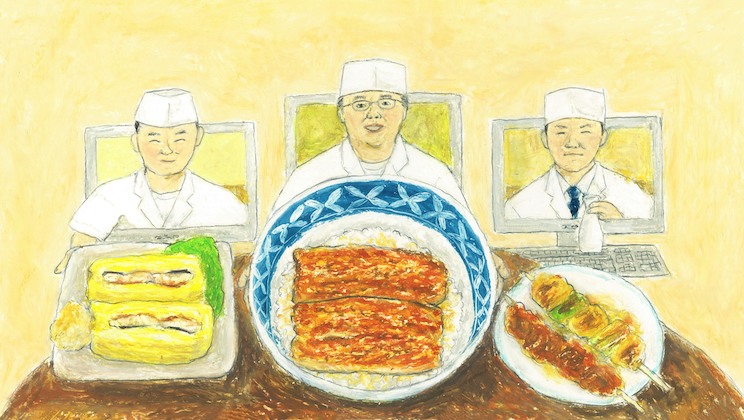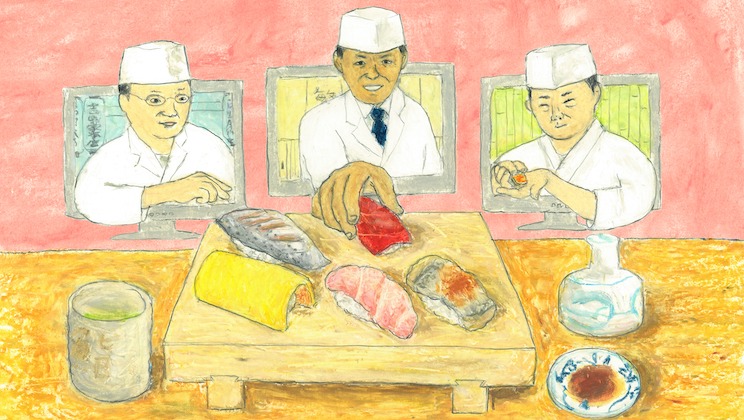“Customers are friends, the restaurant is a small community”. A philosophy of visiting the old and learning new by the 10th generation owner of an eel restaurant, Oedo.
“Customers are friends, the restaurant is a small community”. A philosophy of visiting the old and learning new by the 10th generation owner of an eel restaurant, Oedo.

What would you imagine when you hear “a long-established eel restaurant of over 200 years of history”? Traditional, formalities, or stringent? An eel restaurant, Oedo, in Nihonbashi is a long-established store that flexibly adapts to the changes of the time while holding an unshakable philosophy. What to change and what not to change. The 10th generation owner Mr. Hiroyuki Wakui states that this process of selection is the essence of business. We interviewed Mr. Wakui on the challenges they are currently facing and the relationships with the town and customers.
We’ve been gradually changing the business style and the interior together with the time.
-So tell us about the history of the restaurant.
It is said to have been established in 1800 in Kuramae. At the time, as the name “Kura (storehouse) mae (front)” indicates, the area had many rice granary neighboring each other, and it was like a financial district of the modern days. Also, because it was near the river, it was a great location to carry the eels that were caught in the Sumida River. With the flow of time, the way of carrying the eels changed from water route to land route. Since 1946, we have been in business at the current location.
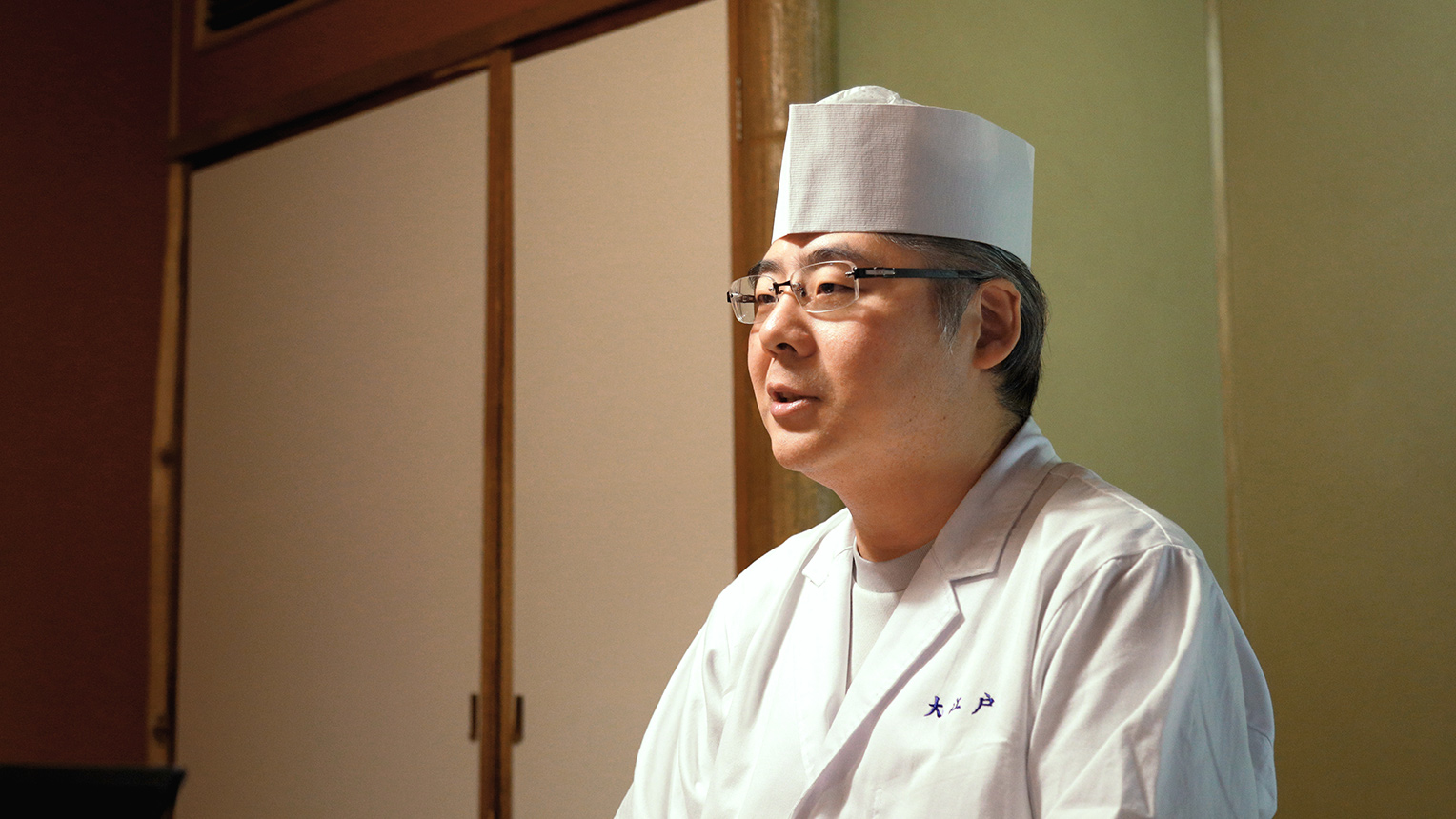
-The place had a different name back then?
The founder Kichibei Sokaya established the place with the name Sokaya. Around the late Edo period, the government army rampaged through the town of Edo, and dispute with the townspeople didn’t stop. Whenever there were disputes, the owner at the time would put the tekkyu (iron stick) used to bake the eels in the back of his kimono and swing it to drive them away. Such actions were relatable to a Yakko-san (champ) so the store was also known as “Yakko Unagi.” There was actually a period when that became the store name.
-That is a very Edokko (Tokyoite)-like episode. What changes did the restaurant have afterward?
Back then, eel dishes were very expensive and was said that you can build a storehouse if 10 customers come a day. Only course meals were served in a tatami room. I heard that it was like a Ryotei (high-end Japanese restaurant) style where the customers would take a bath and change into yukata robes, and spend their time relaxing while drinking. Going onto the Showa era, the place was used for dinner parties while playing mah-jong, the game of go, and shogi. We changed the style to table seating for casual use during the time of the owner two generations back. Now we also place table chairs on the tatami. The style of sitting on the floor cushions have gradually become less popular with the changing time.
With such changes in the styles, we have continued to renovate, make extensions and structural alterations of the building. The ceiling has a level difference and the floors are raised..... You can see the efforts of the carpenters left.
You can’t just maintain the same taste. Long-established restaurant can “stay the same” by continuing to change and adapt.
-It is a lovely building with a taste.
During the period of the bubble economy, we had an idea of making the restaurant into a modern building. However, we thought this type of building is suited for Oedo and that there is a value in keeping it. If we changed to an office building, customers would probably say that the store has degraded even if we continue to run the same way. It’s the same thing when the owners change. It’s painful that the customers say that the place has degraded because of the owner change, even if the new owner follows the exact same thing as the previous generation. We can’t receive recognition if we don’t surpass the previous generations at anything. I believe that evolution is always required.
-The evolution is what makes the restaurant survive for a long time
By changing and adapting with time, people finally accept that it’s the “same” for the first time. In fact, the sauce for the eel is not the same as the old days. It’s important to change according to the customer’s taste each generation. In order to do so, we need to be always aware of the changes in people’s tastes.
-“Changes make same” - this is an idea unique to a store with a great history.
I think most of the long-established places in Nihonbashi has the same idea. I believe that such a way of thinking lies as a culture of the town. But it’s not that everything needs to be changed. It is important that we distinguish the line between what can be changed and what cannot be changed and make selections. Generally, the previous owner does not oppose me for thinking on my own.
But there were times, especially when I was younger, I wanted to try out many things. There were times when the previous owner stopped me from doing something.
-Could you tell us an episode in more details?
I consulted with the previous owner about expanding the restaurant, and he told me that “You cannot open any more than you already have.”
It was an idea that came from wanting to prosper Oedo, but having the base in Nihonbashi was something that shouldn’t be changed. He told me to treasure the feeling of “being able to do business on this land.” It’s the same as the three-way satisfaction of purchaser satisfaction, buyer satisfaction, and society satisfaction. We cannot be the only ones making a profit. Only by thinking this way, the society accepts us. Or else, they would be like “You can’t continue! You’ll eventually be burned down!” (laughs). I really like the atmosphere of Nihonbashi where the whole region is trying to enhance the area together.
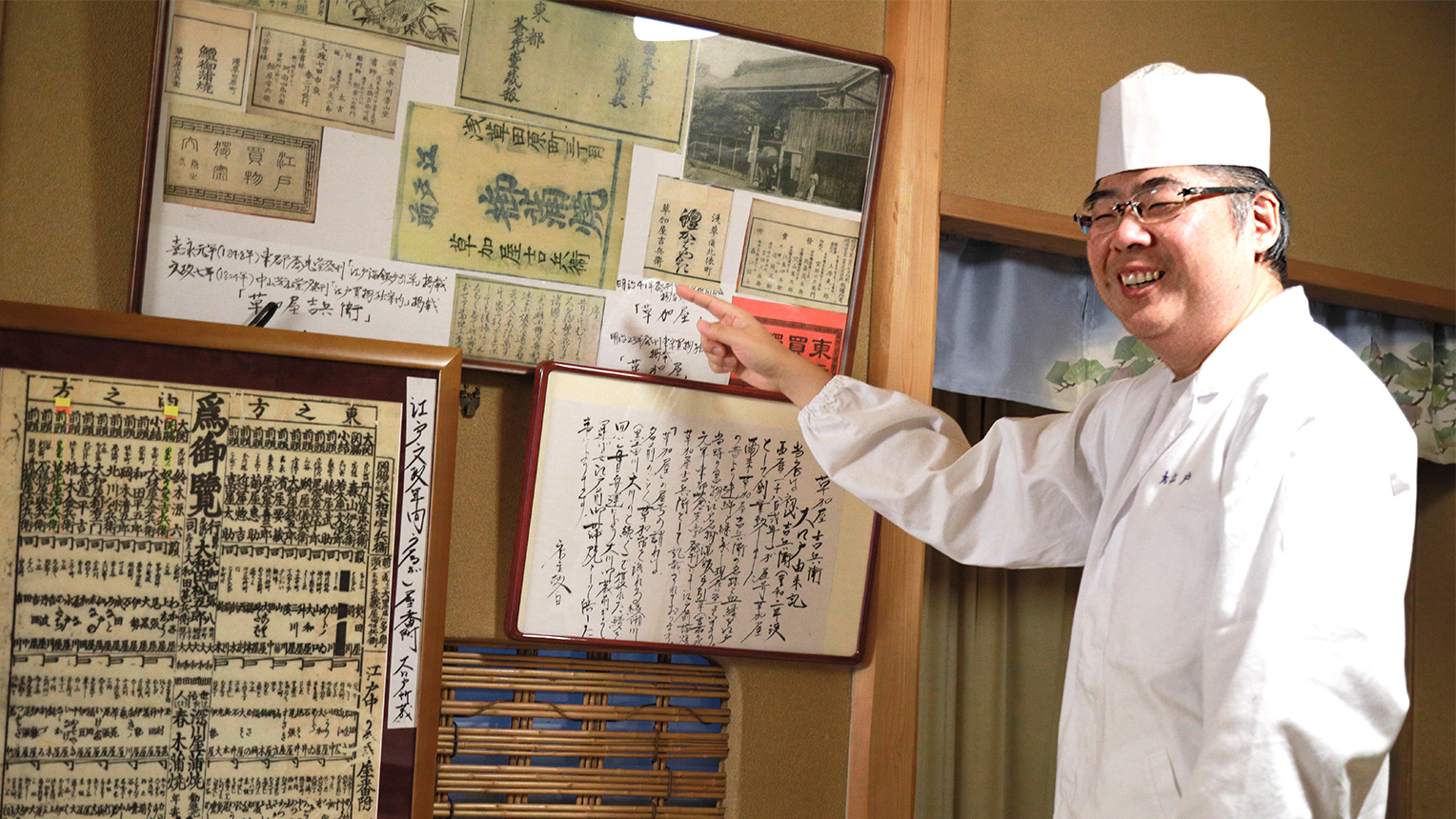
There are many historical documents on display in the entrance
-The town has prospered for a long time because of such a climate.
The other day, I was told by a person doing business in Ginza that “Nihonbashi has a history. I’m jealous you get to do business there. That’s a part that we cannot win no matter how much we make efforts.” We are often compared with Ginza but I was surprised that people in Ginza thought of Nihonbashi in that way. Honestly, I do feel envious of Ginza for being the busiest district in Japan so it made me happy to hear such a comment. I wish to further enhance the good parts of Nihonbashi while respecting the glorious and unified town of Ginza.
I want to prosper the town of food with unique events only a young owner can provide.
-You are also the chairman of the “Miyoshikai,” a youth division of the Nihonbashi Restaurant Association.
There are about 70 people participating in the Miyoshikai. The purpose of the group is to study as a restaurant, and we hold study meetings and social gatherings. Also, we have a movement to expand our activities as Miyoshikai recently, and we have been actively holding events and participating as store booths through cooperation with companies around Nihonbashi. I want to prosper Nihonbashi through the activities of Miyoshikai, and also create the excitement of Nihonbashi as the town of food.
-You mentioned that the purpose is to learn as a restaurant. Do you visit other restaurants and eat there as a group?
As a person working in food industry, eating is also a part of my job. We visit many different restaurants in our study meetings. It links to self-improvement only by eating a wide variety of food, and it is also one of the most exciting parts. The theme of our next study meeting is “The Ultimate beer,” and we plan to learn about the profoundness of pouring beer by inviting a professional from Hiroshima. I was shocked by how delicious the beer he poured was, and I wanted the members of the Miyoshikai to also experience the taste.
-There are also unique events in which the restaurant owners participate in a yukata fashion show. How are those ideas born?
It depends. It can come from ourselves or from meetings with companies about collaborations. We did not have much opportunity to discuss these things so we were inexperienced at first, but gradually, we are starting to have more opinions in the discussions. The youth fears nothing, and there is an atmosphere of not being afraid of mistakes and making actions. But the good part about this town is that the seniors do not put their noses our business. They don’t say that it’s either good or bad, so we don’t know how they actually think of our activity though (laughs).
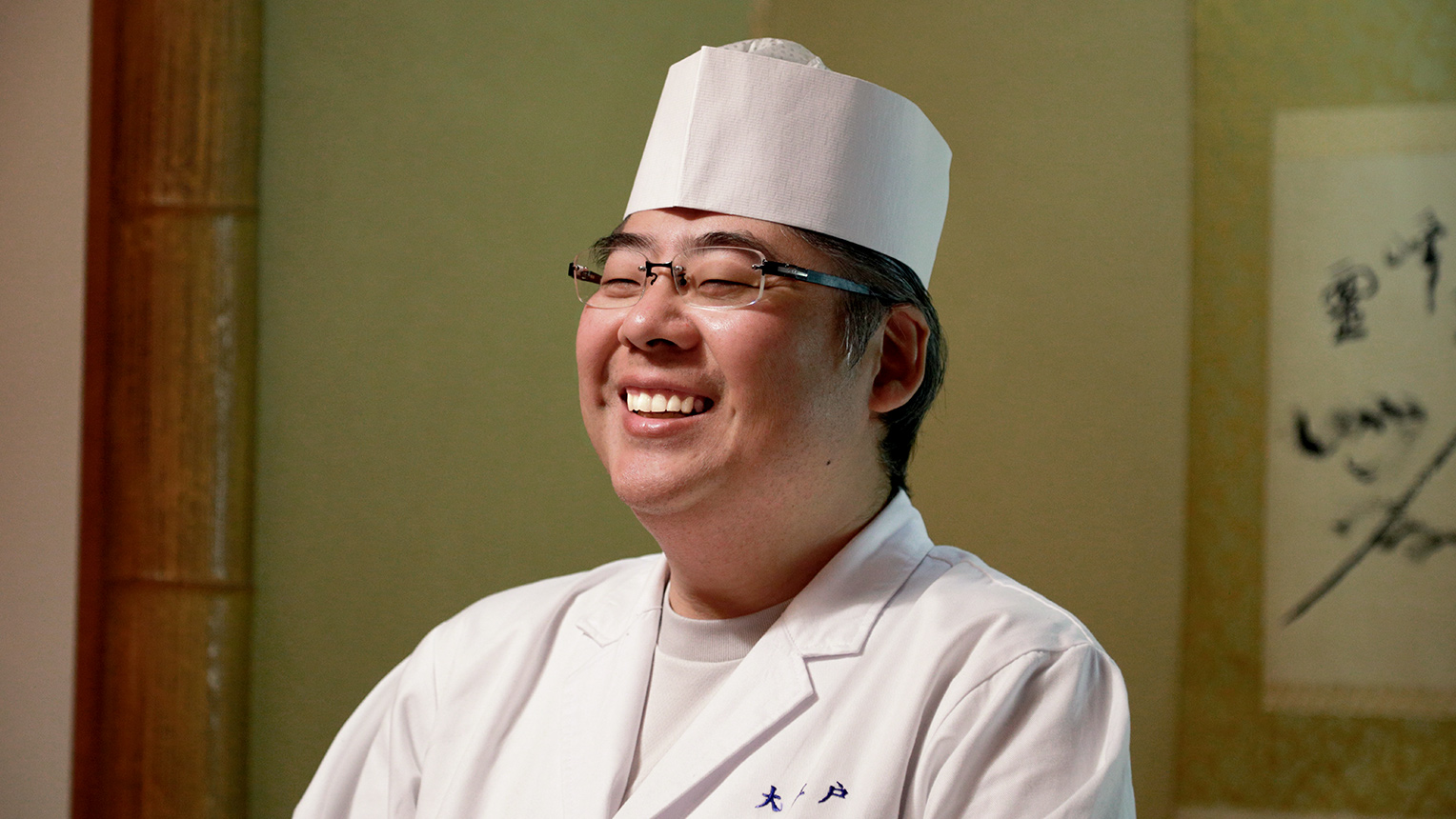
-Are they trying to leave things to the youth to be on their own?
I believe they are. There are many people who think that the town won’t last without succession of generation, and they are always thinking about fostering the next generation. I think they watch over us with a distance of “we’ll watch out and take care if problems arise.” Of course, if we do things as we like, it may arouse bitterness and changes may be difficult to be understood, so we consult beforehand and report to them. This kind of communication is very important.
A low-carb menu at an eel restaurant? The value of a restaurant with history adapting to the time.
-I was surprised to see the low-carb(*) menu when I visited the other day. This is pretty unusual, isn’t it?
There was an initiative to develop a healthy menu as the whole town of Nihonbashi, and the menu was created as a part of that. At Oedo, we provided “una tama chazuke (tea on rice with eel and egg)” that consists of less rice than the usual eel bowl and have an omelet on top instead. When I first heard of the initiative of a low-carb menu at an eel restaurant, it felt like I was brought into a combat or something (laughs). There were many restaurants like eel and sushi places that had difficulty in challenging for a low-carb menu, but we received advice from professionals and worked together creating the menu.
*A diet of gradually controlling sugar (carbohydrate) intake.
-It must have been a big challenge in adapting to the changes in time. Anything that you focused on?
For low-carb meals, it is common to substitute rice with cauliflowers or broccoli but the taste is a little questionable. We wanted to stick to being healthy and delicious and put importance on being able to enjoy the original taste of the restaurant. That makes it Nihonbashi, I think.
Health is a very important keyword in the generations to come, and I also think that there is a value in having restaurants with a history like us to challenge the new generation. I hope that this trend will expand little by little and become a big wave.
Customers are not gods, they are friends. A warm community expands beyond the doors.
-What do you want to do for the prosperity of the town of food, Nihonbashi?
I want more people to know that there are many great restaurants out here. This town has been bad at promoting itself since the old days. The part of it is that people here think promoting or advertising isn’t “cool” or “elegant”. Hence, many of the great restaurants are hidden and only known to those who know. I’m confident that the customers can leave fully satisfied if they get to know the place and come visit once.
The restaurants throughout the town are high leveled, and what’s great about Nihonbashi is that you can enjoy delicious meals wherever you go. Someone who moved to a different town for his job once said that, “Nothing is delicious in the place where I transferred. I want to go back to Nihonbashi!” I thought that was one of the evaluations of the town. It’s actually an old, down-to-earth area, there are many places where you can enjoy with others without playing tough. I wish that many people could get to know of that aspect of the town.
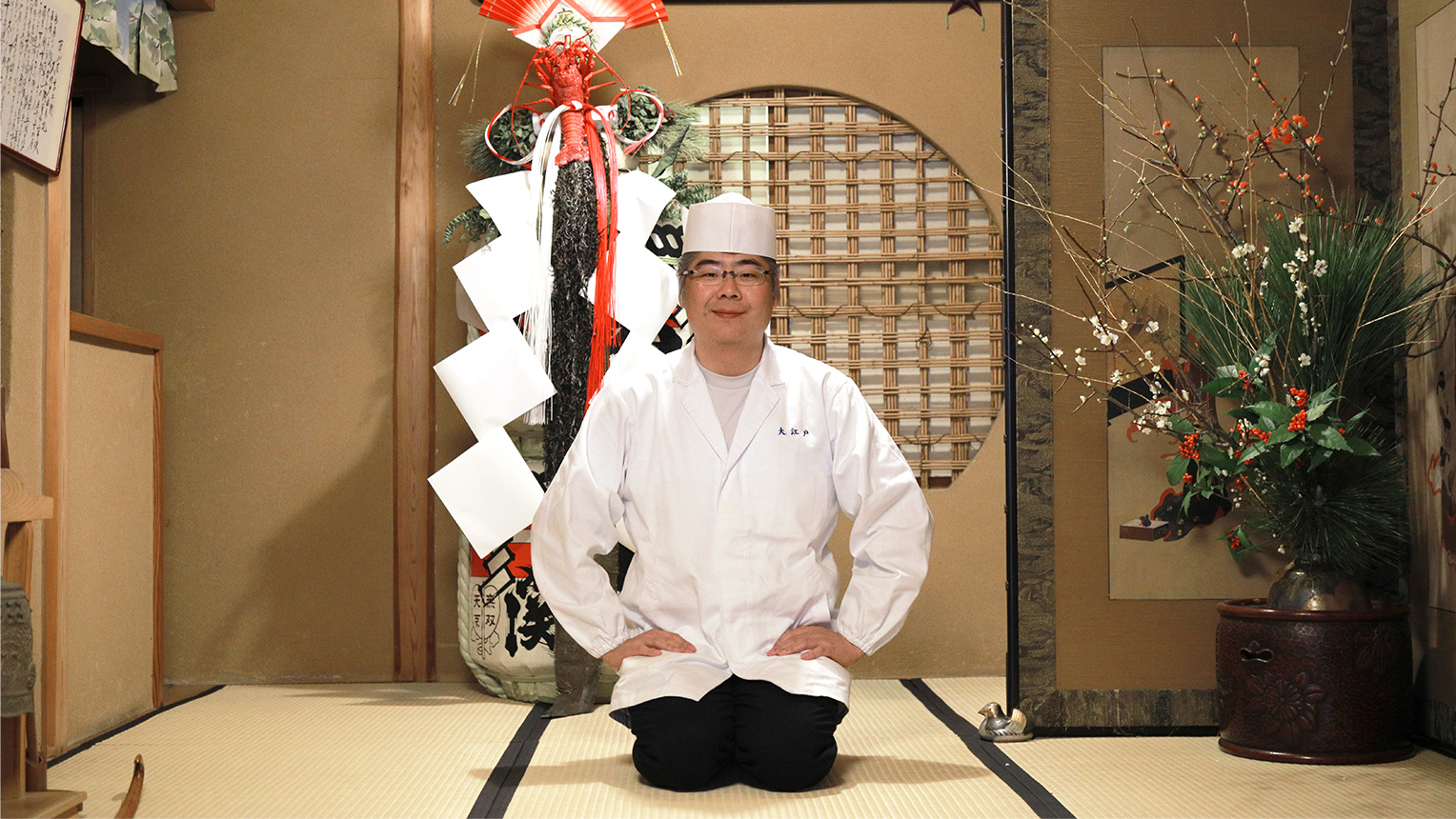
-Actually, there are times you feel the warmth in Nihonbashi, which doesn’t make you think that you are in the center of Tokyo.
If you let me, we don’t really think that customers are gods and we believe that the relationship between the customers and the restaurant should be 50:50. Developing an equal relationship of trust with the customers may bring about a long relationship.
In other words, we believe that customers are friends or one of us who participate in the restaurant community. For instance, sushi restaurants greet customers like “Hey, there!” with a casual greeting with the same eye level. And the customers also come in like “May I come to join you tonight.” This doesn’t happen in a Family Restaurant (casual diner).
-It’s an interesting idea that the restaurants are communities. It may be an atmosphere that has been around this area since the old days, but it seems a bit new in the new era.
The idea of developing the restaurant as a community is a habit that was cultivated through the horizontal connections in Nihonbashi. For instance, when I visit my friend’s restaurant, I become a customer and become a member of the community in the opposite direction. There are many things I learn in such situations. You cannot run a restaurant without knowing the feelings of all standpoints including the customers. That is why I have a habit of making observations while imagining of the feelings of different people each day.
-There may be people who would be interested in such community by reading this interview.
We want many more people to come jump in. But we seem pretty difficult to approach (laughs). We are not obviously opened and may not have a welcoming atmosphere towards all people. But if you could somehow overcome that and knock on our doors, you’ll find a broad-minded, comfortable place. Oedo is also said to have an appearance that’s difficult to go in, but inside is a quite normal restaurant. We intentionally make the place like that, and there is a world only those who opened that door can enjoy. I believe that there lies a special experience that only those who enjoyed that can have.
It would be interesting if young people who are not familiar with the town make connections with the community with a new perspective. I hope that they would knock on our doors by summoning up a little courage.
Interview/Text: Minako Ushida (Konel) Photographs: Tatsuya Sato (Konel)
Oedo
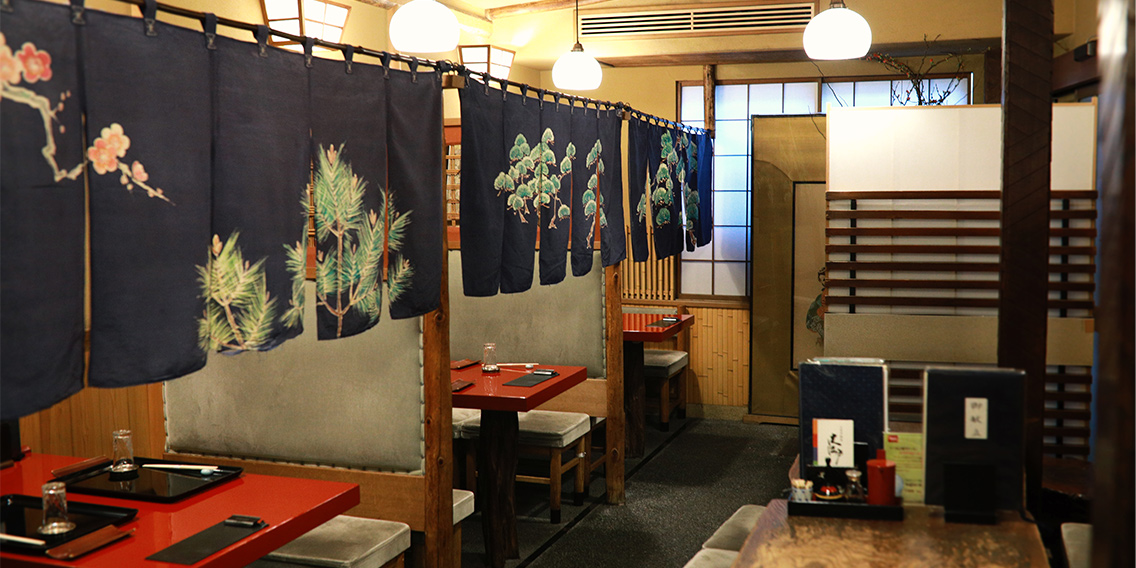
Address: 4-7-10, Nihonbashi-Honcho, Chuo-ku, Tokyo, 103-0023
TEL: (+81) (0) 3-3241-3838
Opening Hours: [Mon - Fri] 11:00 - 22:00 [Sat] 11:00 - 21:00
Closed on: Sundays and holidays
